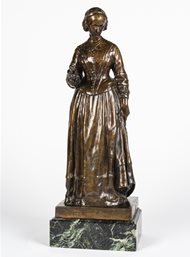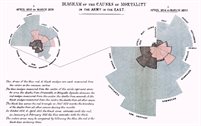The dominance of these well-trodden stories makes it hard to get at the person behind them. A good place to start might be to ask: what might Nightingale have become had the Crimean War never happened? When she left for Turkey in 1854, Nightingale had a burgeoning career as a healthcare manager and administrator. She had just spent a year transforming the Establishment for Ill Gentlewomen, on London's Harley Street, into an efficient, sanitary care home, and was (it appears) about to take up a managerial post at Kings College Hospital. It was her managerial abilities that attracted the British government to enlist her fo the war effort, as much as her practical nursing experience, which - owing to her wealthy family's reluctance to allow her to participate in what was perceived as a low-status occupation - was relatively limited.
The historian Hugh Small has written that Nightingale had the talents and connections to become Prime Minister, had her age allowed this of a woman. But since she lived in the nineteenth century, Nightingale would more likely have ended up as a pioneering (and pioneering female) hospital manager, a passionate advocate of female nursing in civilian hospitals, and possibly even - like a number of her friends and relatives - an early feminist campaigner; she had written a feminist essay, 'Cassandra', in 1851.
But Nightingale did go to the Crimea: a life-defining choice. From that point on there were two Nightingales - the legend, and the live person - that went in different directions. Nightingale, the woman, returned from the war exhausted, wracked by a disease historians now believe to have been brucellosis; she could barely get out of bed for the next fifteen years. She nonetheless threw enormous energy into righting the wrongs she'd seen in the war: campaigning for better sanitation in army barracks, hospitals, and civilian life, and for better nursing, available to all. When the British army went to quell the 1857-58 Indian rebellion, Nightingale became interested in the army in India, and from there, health and sanitation among the wider Indian population. The latter became a consuming interest in later decades, though not to the exclusion of extensive work on hospital design, the development of the nursing profession in the UK, and many other subjects. Meanwhile, the public perception remained dominated by heavily sentimentalised ideas of her Crimean War work.
Nightingale is thus a major figure of nineteenth century history. Her archives, at the British Library and elsewhere, are enormous: second in size only to William Gladstone's. Her Collected Works run to 16 volumes. Innumerable books have been written on Nightingale, but many (especially those aimed at children) are based on legend as much as fact; there remains much to discover about the impact of her (often behind-the-scenes) work, and the texture of her family and friendship networks that produced the social, intellectual and moral capital that she put to use.

A miniature bronze statuette of Nightingale, based on the life-size A.G. Walker statue in London. Statuette courtesy of Peter Kay, photo by UoN Special Collections

Nightingale's "Diagram of the causes of mortality in the army in the East", published in Notes on Matters Affecting the Health, Efficiency, and Hospital Administration of the British Army (1858). Public domain / wikimedia commons.
Although these diagrams are often referred to as 'coxcombs', that was not Nightingale's term, and they should really be referred to as 'polar area graphs', as this article by Eileen Magnello explains.